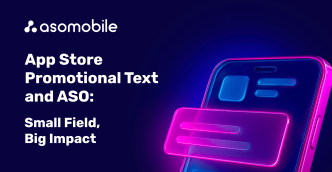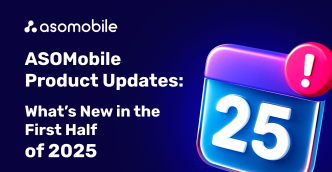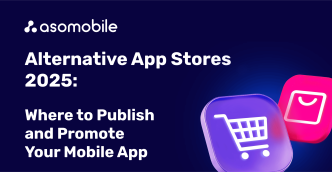15 tips, how to choose an app name
As you name the boat, so shall it float - a well-known aphorism is appropriate when choosing an app name. Before launching a ship, the captain must know for sure:
- where the ship is sailing
- who is it sailing with?
- what is the route of the ship
- and, to the maximum, all the details, nuances, and scenery of the upcoming voyage
This list is easy to extrapolate to the application. Instead of "ship," we substitute "application," and the place of "captain" is occupied by "developer" or "ASO specialist."
At the end of the article, you can find a 40% discount coupon for the first month of using ASOMobile - a tool for creating ASO and researching competitors in the mobile app market.
The more accurate the answers to the questions posed, the more precise and successful the app name will be:
Where is your application heading? Why is it useful? What is unique about it?
What is the target audience for the application? What is the portrait of the end-user?
How will you optimize your application? What is your ASO strategy?
Details, nuances, and scenery - market trends, application placement (Google Play Market or App Store), user mood.
Application name and its importance for ASO optimization
A correct and relevant app name is the first thing a user encounters. It is by the name and icon that the user decides to install or not install the application. Statistics say that about 4% of users read the description of the application, but 100% of users see the name and icon, so it is impossible to overestimate the importance of the name.
A bit of theory. Visual ASO optimization improves the icon, introductory screenshots, and promotional videos, while textual ASO improves the entire letter component of the application.
Here are the three main points that text ASO is aimed at:
Google Play Store:
- The name can contain up to 30 characters
- A short description of the app must be 80 characters long
- The description itself is allowed to fill up to 4000 characters
App Store:
- Title (title) - 30 characters
- Subtitle (subtitle) - 30 characters
- Keyword field gives - 100 characters
30 characters is not that much, so you'll have to use all your creativity to come up with the perfect name for your app. The main prize is worth it - leading places in the top charts of stores and organic search results for user requests.
For the convenience of working with the semantics of applications, in order to take into account the frequency of keywords when they are used in the title, we recommend using the ASO Creator tool from ASOMobile.
We have put together 15 tips for you on choosing an app name.
- Make sure the name of the app reflects its main features.
We are all people, and even more so users. Judging from the first impression, this is a well-known human trait. You can be sad about this, but you can use it. The more accurately the name of the application conveys its essence and functionality, the better. When skimming the search results, the user should have enough of the name of the app to understand its content.
For example, for a messaging app, it would be appropriate to use "Chat" in the name, and in the name of the game, it would be good to add its genre. Lonely "Adventures" looks miserable and faceless, but "Adventures Arcade," tells the user about the genre of the game and, of course, is additionally indexed by stores, which means it increases organic search results.
- Designate your name with a wordplay.
Wordplay is a great opportunity to be creative in the app name. Stand out and be remembered among your category, but not fall out of it. Be careful, your "wordplay" should be understandable to users. What does the French proverb say? The best is the enemy of the good. Be moderate, focus on the target audience of the application, spin in this environment. Dream up. Experiment.
Here is how, for example, the popular instant messenger WhatsApp did. Here, the common youth greeting "What's up!" and "application". Heard and pronounced the same app=up. Here's the play on words in action.
- Keep it short and memorable, but with a harmonious sound. Consider the human factor.
Our brain consumes quite a lot of kilocalories and evolution taught it how to conserve energy. What is easier to remember - a short name or a long one? A clear word or literal abracadabra (contractions, abbreviations)? The answer is obvious - it needs to be short and clear. If a person understands, then they remember. The brain is lazy and fisted for energy, so short words are easier to remember by users, and if you also include its functionality in a short name, then such a successful combo will be remembered even better - associative memory will work. Therefore, the juicy fruits of evolution are at your service. Help yourself - write down the basic requirements.
For example, the name of the application for calling a taxi should be short, and be sure to talk about the functionality. The name "Fast taxi" corresponds to the above parameters. Plus contains additional information - not just taxi, but fast taxi. But remember that brevityб of course, is the soul of wit, but it is never too much of a good thing, so use the legal 30 characters for app names in the stores to the maximum. First, enter a short name, and then add relevant keywords. This will help the application and the user to meet as soon as possible)
- Make your app name an action word.
From a noun to a verb, like Google and its derivative "to google". This word is not in academic dictionaries, but it lives among users and, perhaps, there are few people who do not know the meaning of the word "google". Spin your application, view it from all angles. Is it possible to make it verbal, call the name to action?
- Select a searchable name.
Here we will talk about suitable keywords for optimization. Don't avoid the convenient way to find more relevant keywords for your app - use Keyword Finder from ASOMobile. Ask yourself - how would I look for an app myself? How do other users look for it? Your goal is to define search queries as accurately as possible and use them for the app name. And then the search queries of users will coincide with the name of the app and, accordingly, will be shown more often in the top places of search results.
Let's assume we have an app that reminds the user to drink the amount of water necessary to be healthy. How will the user search for such an app? The first thing that comes to mind is "water," but if you think about it, "drink water" is more likely and logical from the point of view of the user. If the phrase "drink water" is introduced into the name of such an application, then it will be displayed more often and higher for a similar user search query. Which is what we actually need.
- Choose an obvious name.
Think of the name that is on the surface. The most obvious app name usually combines several naming tips at once:
- reflects the main functions of the application
- matches the user search queries
- and such an obvious name is perfectly remembered.
Obviously, you should not invent a bicycle for naming a calorie counter application. Here, the most obvious and the most effective is the "calorie counter". And it reflects the functions, and it corresponds to user requests and you do not need to remember, it is logical)
- Associate the app name with the emotions of users.
Everyone has emotions. Emotions affect everyone personally. Emotions evoke a response. Emotions involve the user much more effectively than meager logical facts. Consider whether it is possible to add a little of something personal and close to each user to the name of your application?
For example, an app with the impersonal name "Fitness" can be "brought closer" to the user simply by adding the personal pronoun "My". "MyFitness" engages the user, because it is no longer just fitness, but their personal fitness. But we will not stop there and will supplement the name with friendly relations - "Pal". And now the full name of the fitness app is "MyFitnessPal" - my fitness buddy. It was personal and emotional. Fitness can be abandoned at any time, but it will be more difficult to lose touch with a "fitness buddy".
- Match the app name with its domain.
Let the results for the user search query include both the application and the URL (link). This is convenient for everyone, both for developers and users. A single brand is a single name on web resources and in stores.
If the guide app is called "Way", then the website domain must also contain "way". Together they are more efficient.
- Consider entering foreign markets - check how your app name sounds or it is translated into other languages.
The market is full of examples of failed translations. When in the local language the name sounds cool, and in the foreign market it turns into something funny at best, and at worst looks intolerant or offensive. The French Danone has a baby food brand called Bledina. This same Bledina in the early 90s began to be actively sold in the territories of the Russian-speakers countries. For obvious reasons, the name had to be changed. In general, do not be Danone, but be visionary strategists, think one step ahead. In order not to turn out to be "Crest" toothpaste from the USA, which, by the way, is very popular there, but for some reason did not take root among the Russian-speaking audience.
- Be concise!.
The two most popular stores - Google Play Market and the App Store - have character limits for the app name. Now, these requirements are identical - 30 characters each in both stores. Until recently, the Google Play Market was more generous and allowed you to fit your fantasy into 50 characters. Therefore, be brief, even though you have 30 characters, do not forget about tip number 3, where we talk about the human factor and dislike for long names. Brevity is the soul of wit.
- Use slang, double or omit letters, mix everything together.
No one knows your application better than you. You know all the pitfalls, target audience, functionality, goodies, and features. Analyze whether it is possible to use slang for the app name? Maybe you should play around with the letters - double, remove or mix everything together? Experiment more boldly, but remember that, for example, slang in the name is likely to attract young people, and the adult generation may also scare them away. Therefore, be sure to carefully define your target audience in order to hit the target more accurately.
- Work with name generators to synthesize two words in a title.
You have been creative for a long, long time and at some point, you are at an impasse. It happens to everyone, take a deep breath through your nose, exhale through your mouth and try playing with name generators (you can find examples of services like Name Generator, Business Name Generator, etc). Even if you have a name idea, do not neglect this tool. It is never too much of a good thing. It does not get any worse than adding a little machine labor to your own ideas. Suddenly, this will lead you to a non-standard solution or an exclusive name.
A great example of a two-word name is the Duolingo language app, formed from “two languages”. Elegant, clear, accessible.
- Don't copy your competitors.
Respect yourself and them. You can and even need to peep what competitors have, look through their applications, read their letters, not for copying, but for understanding and inspiration. Plagiarism is not the best start for any project.
- Don't get hung up on the very first idea.
Brainstorming is designed to stir up creativity. Ideas are born in their agony. Precisely "ideas," precisely in the plural. Do not get hung up on the "firstborn", give the opportunity to other images, synonyms, thoughts, options to be born.
- Final touches.
- Don't overdo it. Obviously, you should not add signs to the name of applications that the user will not type - all kinds of emoticons, brackets, and numbers mixed with letters.
- Try not to use caps lock in the app name, or use it wisely and appropriately. Few people like it when they are “shouted” at and capital letters are perceived that way - with increased intonation. Moreover, in light of the latest changes to the Metadata Requirements Policy from Google Play, this is prohibited.
- If a tasteless candy is dressed up in a colorful wrapper and named rather pretentiously, then this will cause an influx of buyers and a surge in purchases. But actually, once. Tasteless sweets are bought only once. We are trying to say that the name and icon of the application is a candy wrapper, and the application itself with its functions and options is a candy. And it must be really “delicious”. No creative naming will keep users if the application is buggy, poorly designed, with a confusing interface and other troubles.
- Use market research, gather a focus group. Find out what exactly attracts your competitors. The information obtained will help you in creating a unique name.
The app name is the ASO impact point.
The more the app name is indexed by the stores and the more relevant your keywords are in the app name itself, the more successful your ASO strategy is. Because the more correct indexing and relevance, the more often and higher the name of your application is displayed in search results for user queries.
You never get a second chance to make a first impression, which is the app name and its icon. Remember how reverently loving parents approach the choice of a child's name. With what superstitious precautions captains choose names for their ships. And how many streets, parks, and avenues are named after heroes, poets, or public figures. Collect these warm and bright feelings in yourself, mix them with our advice, shake, but do not mix. Pour this invigorating cocktail into your favorite cup and get creative!
 Українська
Українська  Русский
Русский  Español
Español 






